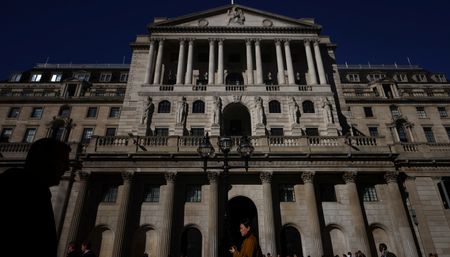By William Schomberg
LONDON (Reuters) -The Bank of England sought to ease concerns about this week’s expiry of its programme designed to calm turmoil in the government bond market, announcing new safety-net measures including a doubling of the maximum size of its debt buy-backs.
Finance minister Kwasi Kwarteng last month sparked a bond rout with plans for unfunded tax cuts, prompting the BoE to say on Sept. 28 it would buy up to 5 billion pounds ($5.53 billion) a day of gilts of at least 20 years duration until Oct. 14.
So far, the BoE has bought far less than the minimum daily limit, but on Monday it said it was taking further steps to ensure the scheme concludes smoothly.
“In the final week of operations, the Bank is announcing additional measures to support an orderly end of its purchase scheme,” the British central bank said in a statement.
Although the maximum auction size was raised to 10 billion pounds in Monday’s operation the BoE bought only 853 million pounds’ worth of debt.
That left its total of bonds acquired since the launch of the emergency programme at less than 6 billion pounds, compared with the 50 billion pound maximum it could have bought.
The BoE said in its statement earlier on Monday that it was prepared to deploy unused purchasing capacity in the remaining auctions this week.
The BoE also said it would launch a temporary expanded collateral repo facility to help banks ease liquidity pressures facing client funds caught up in the turmoil, which threatened pension funds.
The liquidity insurance operations would run beyond the end of this week and would accept a wider range of collateral than usual, including corporate bonds.
In a third move, the BoE said it was prepared to support further easing of liquidity pressures facing liability-driven investment funds through its regular Indexed Long Term Repo operations each Tuesday.
The sharp sell-off in British government bonds after Kwarteng’s “mini-budget” sparked a scramble for cash by Britain’s pension funds which had to post emergency collateral in LDIs.
In a move aimed at calming investors’ nerves, Kwarteng said on Monday he would bring forward his medium-term fiscal plan, including an explanation of how the tax cuts will be paid for, to Oct. 31 from Nov. 23, with independent budget forecasts to be published the same day.
The earlier date will allow the BoE to understand the government’s tax and spending plans before it announces its next interest rate decision on Nov. 3.
“You have lots of risk events coming,” Pooja Kumra, senior European rates strategist at TD Securities, said. “Markets will be looking at each and every auction.”
Yields on British 20- and 30-year gilts jumped by nearly 30 basis points on Monday, approaching their levels during the worst of the market rout triggered by Kwarteng’s mini-budget and adding to a recent run of daily increases.
Antoine Bouvet, a strategist at ING, said low take up of the BoE’s facility so far suggested that risk reduction by pension funds had been limited to date, and the central bank wanted to show it could deploy more support.
“The closer we get to Friday the more gilts will sell off,” Bouvet said. “The bigger picture here is that the functioning of the gilt market is still impaired.”
($1 = 0.9035 pounds)
(Additional reporting by Tommy Wilkes, Harry Robertson, Muvija M and Sachin Ravikumar; Writing by William Schomberg; Editing by Catherine Evans)


